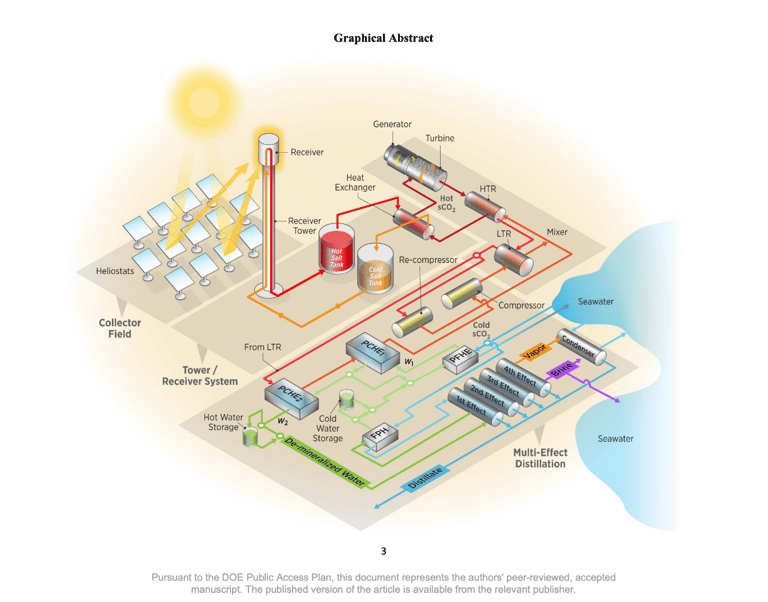SunSandPower
Integrated Solar Thermal System for Cogeneration of Electricity and Fresh Water
The global demand for sustainable energy and water resources has become increasingly urgent in addressing the challenges of climate change. In response to these issues, this project proposes the development of an innovative system that harnesses solar thermal energy and uses sand as a storage medium to cogenerate electricity and fresh water. This integrated solar thermal system offers a promising solution to meet the growing needs for clean energy and water.
The proposed system consists of a solar tower, a thermal energy storage unit, a supercritical carbon dioxide (sCO₂) engine, and a multi-effect distillation (MED) plant. The solar tower includes a central receiver surrounded by a field of mirrors (heliostats) that track sunlight and focus it onto the receiver at the top of the tower.
The collected solar heat is stored in a thermal energy storage medium to enable continuous operation after sunset.
Current methods for storing thermal energy primarily rely on molten salt as the storage medium. However, molten salts come with high fixed and operational costs due to their complex maintenance requirements. Their limited thermal stability at very high temperatures also restricts their use in powering highly efficient thermodynamic cycles.
In contrast, sand—an abundant and low-cost material—has emerged as a promising alternative for high-temperature sensible thermal energy storage. It requires minimal maintenance and can withstand much higher temperatures than molten salt. Additionally, sand exhibits favorable thermal properties at elevated temperatures, with a specific heat capacity ranging from 60% to 100% of that of water.
The charging process involves transferring heat from the solar receiver to the sand through a heat transfer fluid, gradually raising the sand’s temperature. Sand can withstand temperatures up to 1700°C without undergoing a phase change. With appropriate system design and material selection, sand batteries can retain heat for several weeks, making them suitable for long-duration energy storage and grid balancing [1].
The discharging process involves circulating a cooler fluid through a heat exchanger embedded in the sand, extracting the stored thermal energy. This energy is then used to power a supercritical CO₂ engine operating on a modified Rankine cycle.
The Rankine cycle is a thermodynamic process used to convert heat into mechanical work. Recent innovations use supercritical CO₂ in a Brayton cycle configuration, where the working fluid does not undergo a phase change, unlike steam in conventional turbines. This eliminates latent heat losses, making the system more efficient. Supercritical CO₂ systems offer advantages such as high heat transfer efficiency, reduced pumping losses, compact size, and increased power output—all with little to no emissions [2]. Since the CO₂ is enclosed in a sealed loop, it eliminates the need for large cooling towers and conserves water. The system also rejects heat at temperatures above 70°C, ideal for use in multi-effect distillation.
Multi-effect distillation (MED) is among the most efficient thermal desalination methods. In MED, seawater is sprayed onto heated tubes, turning it into steam. This steam is then used in subsequent stages to heat more seawater, continuing the process until the temperature drops to ambient. MED typically operates at around 70°C. Recent advancements include using materials such as silica gel, which exhibit temperature-dependent hydrophobic or hydrophilic behavior. These materials extend the effective temperature range, improving system efficiency [3].
By integrating these components—solar thermal energy collection, sand-based thermal energy storage, a supercritical CO₂ engine, and a multi-effect distillation plant—this system can simultaneously produce electricity and fresh water using abundant solar resources. It provides a sustainable and scalable solution to address the increasing global demands for clean energy and water, while tackling climate change and water scarcity.
References:
https://www.osti.gov/servlets/purl/1502344
1- https://www.irjet.net/archives/V6/i4/IRJET-V6I41143.pdf


Energy and Water security for Arid Regions
